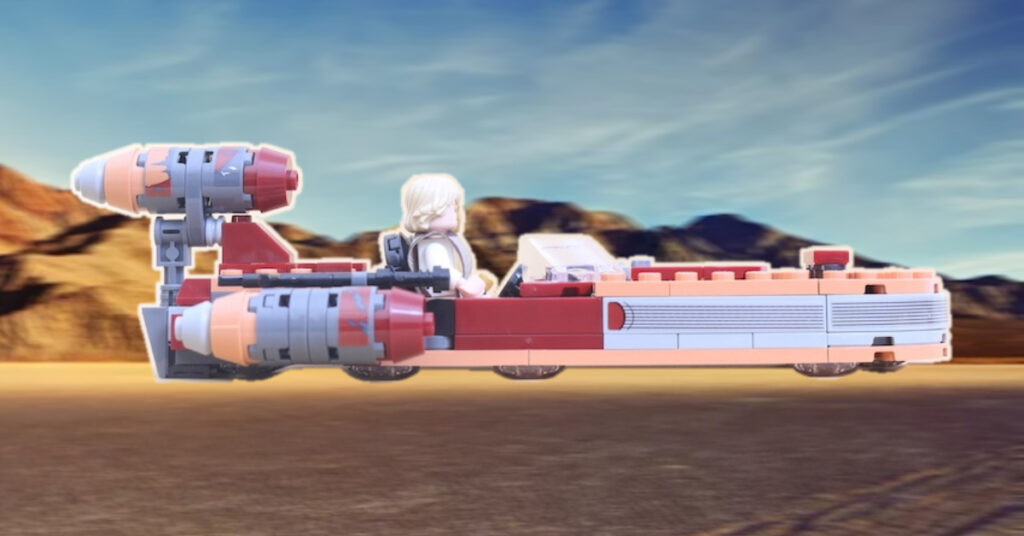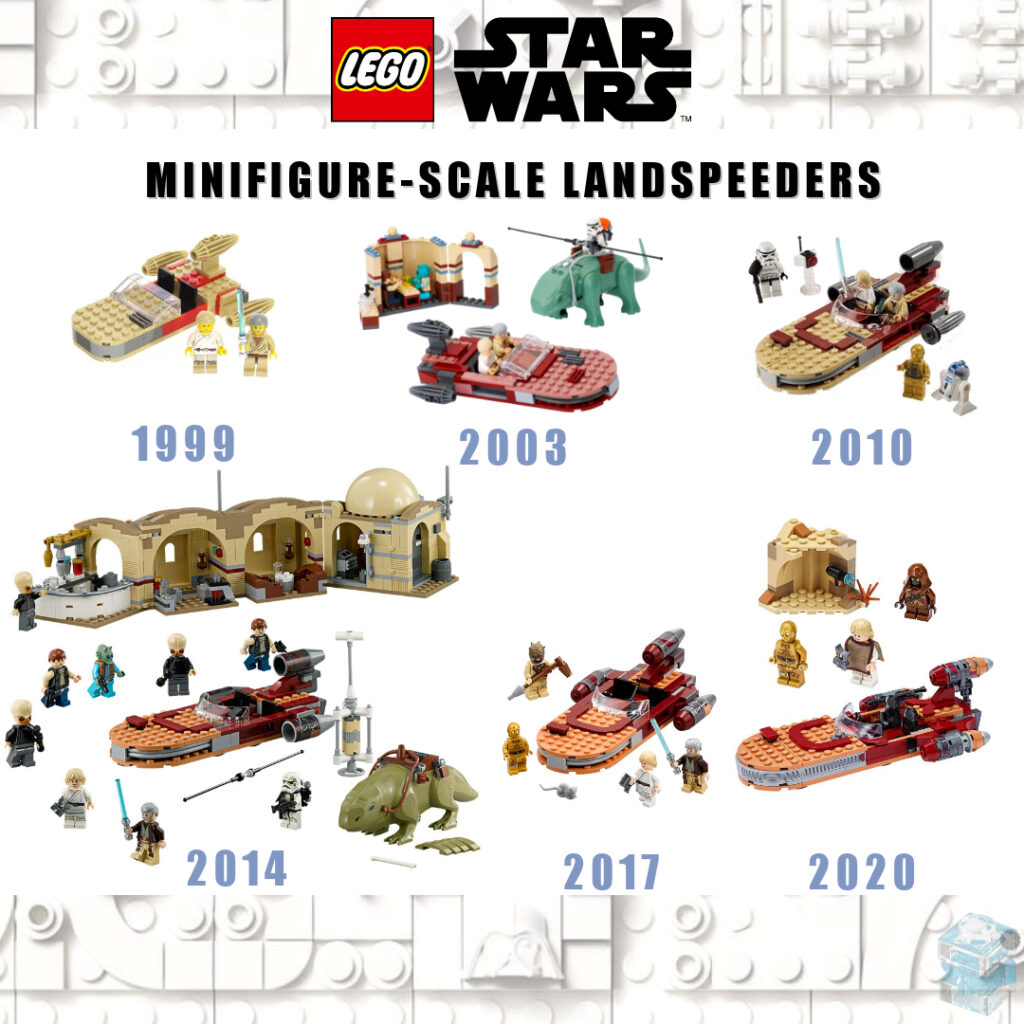
As a perennial set in an evergreen theme, LEGO is often accused by Star Wars collectors and its fan base of producing too many landspeeders, and with the recent release of 75341 Luke Skywalker’s Landspeeder the debate has been reignited, so we wanted to look back at all the landspeeders and determine if LEGO has a gone a landspeeder too far.
At the risk of getting overly dendrological, the term evergreen – when applied to LEGO – means that sets are being continually, and without break, added to the theme. Other evergreen themes include City (which started out as Legoland Town), Space (including Classic, Life on Mars, Mars Mission, Space Police, etc) and Castle (covering Classic, Fright Knights, Knights Kingdom, Forestmen, Kingdom, etc) – all of which began in 1978 with the birth of the modern minifigure.
For a long time, these were the only three evergreen themes and that didn’t change until well into the 21st century.
Wait, LEGO Star Wars kicked off in 1999, right? That’s true, but it didn’t immediately become an evergreen theme – the first license was only for seven years, and LEGO was contracted to produce sets from the Original Trilogy and the next three movies – so it was when the license was renewed in February 2007 the seeds for the next crop of Star Wars sets were planted.
With the renewal of the license, LEGO had to look at what new sets – based on existing and new material – could be added to the theme, and that had to include revisiting existing models. If it hadn’t been for the development of The Clone Wars animated series, the Star Wars line would have stayed an ephemeral one and over twenty years later collectors wouldn’t be bemoaning that there are too many landspeeders.
So just how many are there? To answer that required a bit of digging through our sets database, which revealed that there are four scales – nano, micro, mini and System (minifigure) – that the landspeeder is made in, giving a total of 16, including the accessory in 40531 Lars Family Homestead Kitchen and the new Ultimate Collector Series set.
- 7110 Landspeeder (1999)
- 4501 Mos Eisley Cantina (2003)
- 852245 Landspeeder Bag Charm* (2008)
- 8092 Luke’s Landspeeder (2010)
- comcon024 Luke Skywalker’s Mini Landspeeder* (2012)
- 75052 Mos Eisley Cantina (2014)
- 75056 LEGO Star Wars Advent Calendar* (2014)
- celeb2015 Tatooine Mini-build with C-3PO* / fanexpo002 with R2-D2* (2015)
- 911608 Landspeeder Foil Pack* (2016)
- 75173 Landspeeder (2017)
- 852768 Landspeeder Bag Charm* (2018)
- 75213 LEGO Star Wars Advent Calendar* (2018)
- 75271 Luke Skywalker’s Landspeeder (2020)
- 40451 Tatooine Homestead* (2021)
- 40531 Lars Family Homestead Kitchen* (2022)
- 75341 Luke Skywalker’s Landspeeder*
That sounds like a lot, but stripping out all the non-System sets (marked *) only leaves six sets that are appropriate to minifigure play. Of that six, four are dedicated landspeeder sets and two are ancillary to the set’s primary focus. A quick calculation shows that over the last 23 years the landspeeder has cycled around every 5.75 years on average, or 3.83 years if you include the X-34 landspeeders in the two Mos Eisley Cantina sets.
That’s roughly one new landspeeder every 5 years.
In reviewing the list of all the sets that have included a System-scale landspeeder it’s clear that the periods between the sets – four years, followed by seven years, then four years, and two landspeeders separated by three year gaps – shows that at no point were two landspeeder models available at the same time.

With the LEGO Star Wars theme continually drawing in new fans it was a foregone conclusion that the Star Wars design team would have to look back at older sets. Sticking with the botanical analogy, a perennial plant is one that lives more than two years, and given that the lifespan of a LEGO set is 18 to 24 months, according to Brickflip.com, most reoccurring LEGO sets like Luke’s landspeeder are perennials.
Has the garden that is LEGO Star Wars never been choked by landspeeders, and is it fair to consider them the weed of the LEGO Star Wars theme? Not really.
If the reason for introducing the landspeeder every 4 to 6 years is to provide new fans of the LEGO Star Wars theme a fun and affordable entry set, then why retire it in the first place? The answer to this, writes BrickBucks.net, is five-fold:
- Production capacities aren’t limitless
- LEGO designers come up with new techniques
- Retailers need refreshed stock
- Consumers want improved products
- Source material changes
Of course, sets can be re-issued or brought out of retirement, but in the history of the LEGO Star Wars theme only two sets have been resurrected as is when LEGO renumbered 7140 X-wing Fighter and 7150 TIE Fighter and Y-wing as 7142 and 7152 in August 2002, a year after they were retired.
LEGO could just continue producing the same set over and over again, but would you want to still be looking at the blocky and ungainly 7110 Landspeeder for over 20 years? The likely answer is no, so who is it that’s complaining about the so-called profusion of landspeeder sets?
By and large, there are two kinds of people who buy LEGO – whether it is a child or an adult – there’s the average person who likes to build the occasional set and then there’s the collector who purchases them in an almost compulsive manner. Neither of those is likely to complain of too many of one set.
However, when you add an intellectual property (IP) to the flower bed you’ve suddenly got a new organism to account for – the fan. When you graft fandom onto the average LEGO consumer you don’t get much of a change, but if that fan focuses on Star Wars and is a collector then you’ve got a hybrid like no other, and it’s where most of the complaints that there are too many landspeeders is coming from.
Taking a step back to see the woods instead of the trees, consider that of over 600 different LEGO Star Wars construction sets less than 2% of them are landspeeders.
So, other than redesigning old Star Wars models or keeping the original in production, what other options does LEGO have?
There’s only one realistic choice left – LEGO could make a set once and never release it again after it retires. So far this has only happened with three mainstream sets: 7113 Tusken Raider Encounter, 7133 Bounty Hunter Pursuit, and 7153 Jango Fett’s Slave I. Since all of these sets are continually appearing on fans’ wish lists it’s inconceivable that if LEGO decided to go this route the LEGO Star Wars collecting community would stay silent.
At the end of the day – and this feature – it all comes down to the LEGO Star Wars collector’s choice to either accept that new fans of the line are going to want the occasional landspeeder, or opt not to buy any more landspeeders.
Either way, brace yourself for 2024!


Be the first to comment